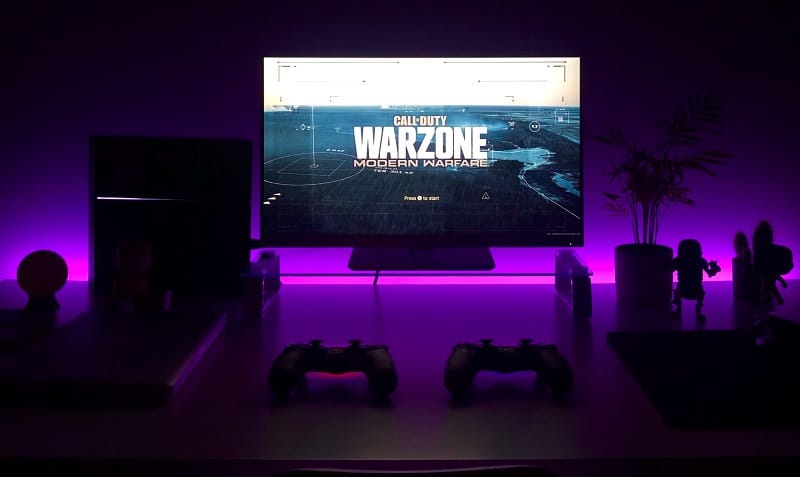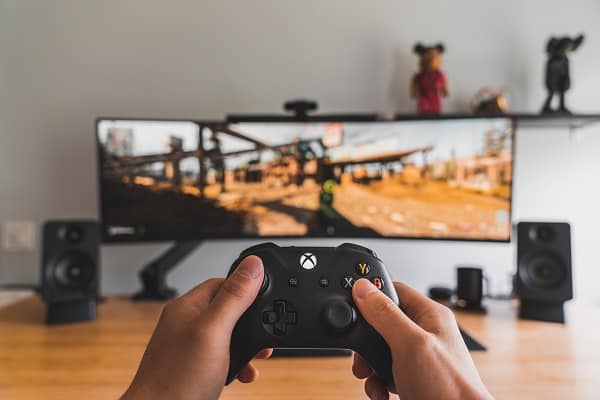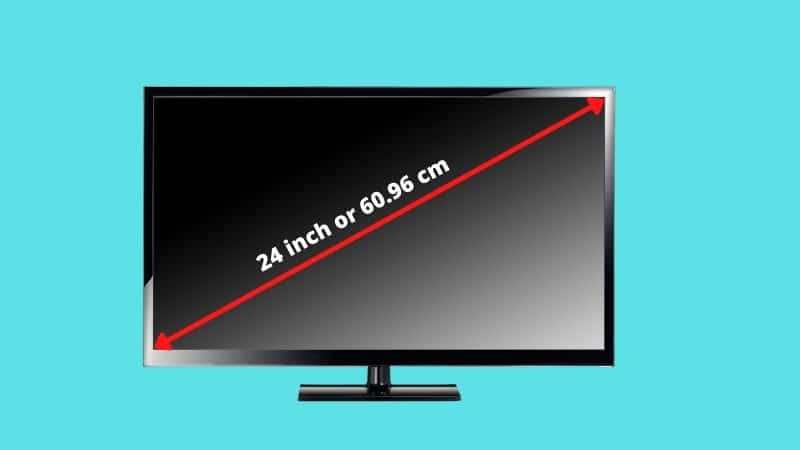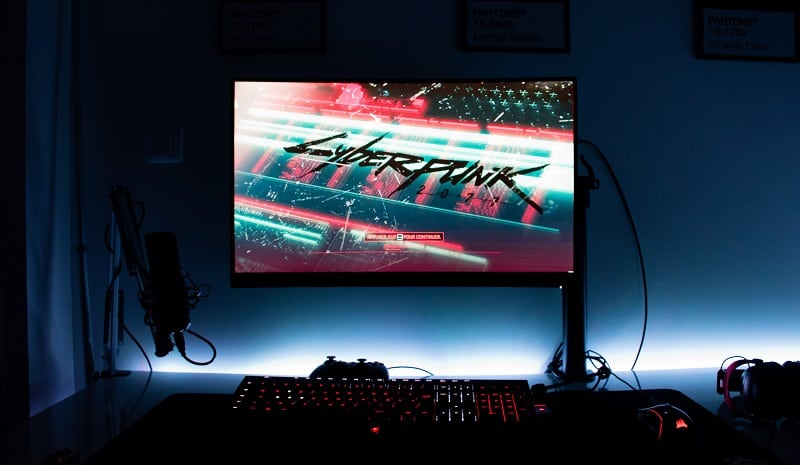With all the terms and functionalities companies use in their promotion, it’s easy to become confused while looking for the ideal monitor size for gaming. Monitors for gaming are available in a variety of sizes and resolutions. So, precisely what is the perfect monitor size for gaming
The optimum monitor size for gaming is between 24 to 27 inches, with a minimum resolution of 1080p, HDR and G-Sync support, and a frame rate of at minimum 120 Hz. Most professional gamers choose 27-inch display displays with a minimum frame rate of 244 Hz for esports gaming.
Hence, finding the perfect gaming monitor size depends on many different criteria. So, if you are looking for the ideal gaming monitor size, our guide has got you covered.
What is the best monitor size for gaming?
The appropriate monitor size is determined by the resolution and the distance between you and the display. Generally, most people believe that 1920×1080 should not be utilized on screens greater than 25 inches; 1440p is suitable for screens larger than 27 inches; and 4K is wonderful for screens larger than 27 inches to 43 inches, depending on personal choice.
Bigger displays are now the standard, although compact displays have their advantages and are preferred for some applications. 24 and 25-inch monitors provide ample screen area for gaming, making it simpler to view everything in your field of vision, such as maps, during competitive play.
These displays are ideal for fast-paced FPS games but not so much for games that require deeper immersion, such as adventure or role-playing games. However, according to most gamers, 32-inch size is too big for them.
Best monitor size for 1440p gaming
1440p resolution is also known as WQHD; it has a resolution of 2560×1440. Hence, the ideal size monitor for this resolution gaming is 27 inches. It’s because the balance point for 1440p or WQHD is 27 inches. While this quality isn’t UHD, it’s still a significant improvement over 1080p.
If your Computer system can support it, 1440p provides for greater refresh rates over 4K. Because no scaling is required, you obtain 108 PPI, which is the perfect balance between picture resolution quality and accessible display real estate.
32-inch monitors are adaptable since they come in a variety of sizes. High refresh rates and quick reaction periods are featured in 1440p versions, making them perfect for fast-paced gaming. However, as previously said, many gamers consider 32 inches to be too large for gaming.
What monitor size Should I Get for 1080p gaming
For 1080p gaming, you should go for a minimum of a 24-inch monitor. These displays usually have a resolution of 1980x1080p. On a 24-inch display, High Definition resolution yields a pixel density of around 91 PPI, which is enough for visual details and display real estate.
Since they can attain greater refresh rates, 1080p displays are favored among gamers. There are several 27-inch 1080p monitors on the market. But, we would advise against buying one.
A 27-inch monitor is just too large for 1080p, with an average PPI of 81, resulting in a fragmented image. As a result, the letters will be smudged, and the details will be hazy.
Best monitor size for 4k gaming
Finding the ideal display size for 4K resolution may be difficult. A monitor with a minimum size of 32 inches is recommended. Suppose the monitor isn’t big enough. Because of the high resolution, anything on display will be tiny. Therefore you’ll have to scale the UI to make the text understandable.
Some UI components may seem small if a game does not allow for configurable scaling. However, if your eyesight is perfectly fine, a 27″ display that is more than a meter away, 4K should be enough.
People think 27″ is too tiny since they’re squinting at a limited FOV of 3840 pixels wide while sitting 1-2 meters away from the display. Nevertheless, if you plan on gaming in 4K, we recommend investing in a huge monitor.
Here is a video that compares 24-inch, 27-inch, and 32-inch monitors with resolution.
What is the Right monitor size for competitive gaming

Professional eSports players are required to utilize a display monitor with a size of 24 to 27 inches by standard, as this is the industry norm. Any screen larger than 27 inches is deemed excessive. Because games are contested in milliseconds, tournament players want the quickest displays available.
Many professionals utilize 24-inch monitors to get the quickest feasible rates, even if it means sacrificing resolution. The refresh rate, which defines how fps the monitor can show, is at the heart of everything. The visuals are much more realistic and smooth when more frames are presented.
As a point of fact, 99 percent of gamers utilize a gaming monitor with a minimum refresh rate of 144 Hz when it comes to frame rate. Because higher resolutions result in far more pixels on display, refresh rates are lower. The image quality isn’t the best on most 24-inch monitors because they keep to 1080p resolution; however, the refresh rate is high.
monitor size for FPS gaming
24 and 25-inch monitors provide ample screen area for gaming, making it simpler to view it all in your range of view, such as landscapes, during tournament play. These displays are ideal for fast-paced FPS games but not so much for games that require deeper immersion, such as adventure or role-playing games.
Smaller displays, sometimes even exceeding resolution, are preferred by FPS gamers because they provide faster refresh rates and bring the action closer to the player.
Big displays do, without a doubt, provide more resolution, but they do so at the expense of refresh rate, which is why they aren’t as famous amongst professional FPS gamers.
Which monitor size Should I Choose for regular gaming

If you’re a casual gamer seeking to buy a gaming monitor, you don’t have to spend a lot of money on a high-end model. For casual gaming, a 27-inch display is more than adequate.
Surprisingly, many individuals would argue that 27 inch is the ideal display size for gaming. As a matter of fact, most gaming monitors come in 27-inch sizes. There are monitors with 60Hz refresh rates and astonishing 240Hz refresh rates available, ranging from simple 1080p panels to high 4k resolutions.
monitor size for console gaming

For console gaming, you should use a 32-inch monitor. Console gamers will benefit from 32-inch displays. Because of the bigger screen, console gamers can sit back and enjoy the vivid images. In comparison, 32-inch monitors are available in a variety of resolutions.
These monitors are more suited to some games than others. The bigger display allows for more detailed visuals, which is especially useful in higher-quality models.
Console gamers will benefit from 32-inch displays. Because of the bigger screen, console gamers can chill and enjoy the vivid images. 32-inch displays are also available for PC gamers, although they aren’t ideal for competitive gaming.
However, keep in mind that 32-inch monitors may not offer the fastest reaction times because of their bigger size. Altogether, 32-inch monitors have a huge screen and are ideal for gaming on consoles.
Ultrawide monitor for gaming

In contrast to the usual 16:9 aspect ratio, ultrawide displays have a 21:9 or 32:9 aspect ratio. The increased horizontal area and frequently curved screen encompass your field of vision for a more realistic gameplay experience.
Depending on your game, ultrawide displays may be a fantastic option. Racing games, in particular, benefit significantly from ultrawide displays. Thus investing in a high-resolution monitor may be worthwhile. Because of the amount of information on the screen, 34-inch displays provide a fantastic experience for supported games.
Ultrawide displays are typically 34 inches in size and have identical resolutions; the difference is in the refresh rates. 3440×1440, commonly known as UWQHD, is the most prevalent resolution. The other resolution is 2560×1080.
Furthermore, 34-inch monitors don’t have the quickest refresh rates due to their large screen size, which is a disadvantage in competitive gaming where speed is crucial, such as FPS games.
Many recent FPS games, for example, will not allow for a vertical FOV greater than 90 degrees. On a 16:9 panel, this is OK, and on an ultrawide monitor, it can cause a stretched or distorted image.
How is Monitor size measured?

Monitors, like TVs, are measured diagonally. The diagonal length of a screen, which is also the distance between opposing edges in inches, is commonly used to characterize its dimensions.
It’s also known as the physical image size to differentiate it from the “theoretical image size,” which is defined in pixels and indicates a screen’s display resolution. A simple example can help us better comprehend this measurement.
A regular 27-inch monitor is 27 inches diagonally. Although, the display screen is generally 24-inches wide and 14-inches in height. After that, the stand adds further height. Again, a 24-inch monitor is 24 inches or 60.96 cm diagonally.
How gaming monitor is evaluated?

Size is only the first factor in evaluating a gaming monitor; many other factors need a detailed assessment before selecting the perfect gaming monitor. The greatest gaming display is one that gives you a terrific gameplay experience, regardless of whether you’re playing on a PC or a console.
Refresh rate
The refresh rate is the most crucial consideration when purchasing a gaming monitor. This is more important than the screen size. A gaming monitor’s refresh rate is the number of times it draws a new output on the screen per second.
The higher the refresh rate, the closer you are to being in a real-world situation where you can observe and react as soon as practically feasible. When selecting gaming monitors, strive to find the maximum refresh rate feasible within your budget.
We suggest 144 HZ as the minimal refresh rate norm in today’s modern gaming industry. Any purchase that is equivalent to or more than that is a great one.
Also, keep in mind that greater resolution and refresh rates need the use of solid graphics cards. So, make sure your internals are covered because, without them, a faster refresh rate will not help you in any way.
HDR
HDR stands for High Dynamic Range, and it allows your gaming monitor to display a wider variety of colors and intensities, leading to a more vibrant image. If you like gaming on your console or on Windows, an HDR display will provide you with better video quality.
In layman’s terms, this implies that an HDR monitor displays subtleties and color hues more accurately and with greater detail in light and dark. However, bear in mind that in order to fully utilize HDR technology, the game must be in sync as well.
Minimal Shuttering
We also suggest purchasing monitors that have adaptive sync technology, such as free sync, G sync compatible, G sync, or G sync ultimate.
As you progress through these categories of adaptive sync technology, the functionality and cost will grow. To avoid screen tearing or shuttering during gaming, adaptive sync technology is essential.
G-sync is another option. Nvidia’s frame sync technique is known as this. It uses specialized hardware in the display to match your GPU’s output to the refresh rate of your gaming panel for the best gaming experience possible.
Another feature on a display that you must have if you have a budget and are a professional player is overdrive. You may use reaction time overdrive to increase the monitor’s response time and pixel changeover duration.
This reduces the amount of trailing/ghosting artifacts that appear after fast-moving items. Overdrive can produce pixel overrun or reverse ghosting based on the refresh rate.
Here is a video on what to consider before buying a gaming monitor.
Type of Panel
Computer Monitor comes in three different categories of the panel. They are IPS, VA, and TN.
TN Panel
If you want to play with other gamers in shooters or fighting games or simply enjoy the maximum frame rate available, TN is the way to go.
Because TN panels have better contrast ratios, you may anticipate bright colors and accurate color replication, although the color quality isn’t as excellent as IPS. The brightness of the screen may also change based on the angle from which you see it.
IPS Panel
Select IPS if you want to play your games with the most vibrant colors available and angles of sight. Another area where IPS outperforms all rivals is in this area.
IPS gaming displays maintain brightness levels even from shallow points, thanks to 178/178 degrees on the vertical and horizontal axes. However, compared to TN screens, the refresh rate is lower.
VA Panel
When compared to IPS and TN panels, VA panels have the lowest efficiency. Compared to IPS panels, VA panels are somewhat behind the curve in color fidelity, but they are adequate for most gaming applications.
They thrive in games when it comes to shadowing and highlighting detail, and the darker blacks make them a terrific choice for viewing films in your spare time.
FAQs
So. far, we have discussed the adequate monitor size for gaming from different perspectives. But, there are a few frequently asked questions that we must discuss to understand the discussion better.
Is a 27-inch gaming monitor too big?
Answer: When we are talking about 1080p gaming, a 27-inch monitor is too big as you will not get the total 91 pixels from it. However, for 1440p resolution gaming, a 27-inch gaming monitor is just perfect, and you will never find it too big.
Is a 32-inch gaming monitor too big?
Answer: A 32-inch monitor is typically too large for high-end gaming, but it might be ideal for some sorts of office work, multimedia watching, and everyday tasks. A 32-inch monitor will make it difficult for gamers to see all of the corners. However, a minimum of a 32-inch monitor is required for 4K resolution to have the best immersive gaming experience.
Why do Pros use a 24-inch gaming monitor?
Answer: Professionals choose 24-inch monitors for a number of reasons. The most important reason is the incredibly high frame rates, but some come with QHD for gaming. 24-inch displays have also become the norm at gaming competitions, forcing professional players to adapt or risk being left behind.
Is 1080p Vs 1440p noticeable?
Answer: The pixels on a 1440p panel are 78 percent higher than those on a 1080p monitor. This results in a larger screen, which is ideal for those who want to get the most out of their display. Furthermore, 1440p provides a better and more intense gameplay experience.
Conclusion
Finding the ideal monitor size for gaming can be pretty confusing, mainly due to so many different choices available. To briefly answer, smaller monitors are better for professional gamers due to their faster refresh rate. For professional gamers, refresh rate matters more than actual screen size.
On the other hand, bigger monitors will just do fine for casual gamers. But, make sure the resolution is at least 1440p or more for bigger monitors. If you opt for a larger 1080p screen, the images and details will look blurry.
Apart from monitor dimensions, you may want to consider panel type and refresh rate while choosing gaming monitors, as these aspects play a significant part in selecting gaming monitors.

Hello Good People! This is Pavel and Welcome to PC Delight!
I’m an Electronics Engineer by profession with a passion for Gaming & PC builds. When I came up with the idea for PC Delight, it was my goal to share & offer the very best PC building ideas to tech-loving people like myself.
Since my school days, I’ve been just addicted to gaming & PCs. That leads me to experiment with various ways around the very niche, resulting in great productivity. And I’m here to share those practical experiences. So that next time you start some experiment with your PC builds or struggle to cope with a certain game, I’m here with the solutions. With these philosophies, I started my journey in 2017 and just kept going.



